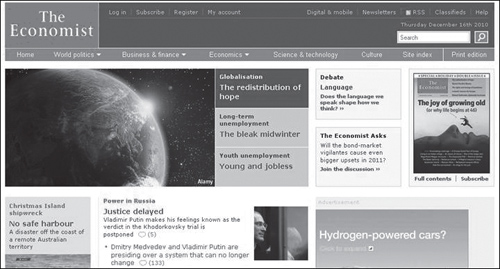Sample Drupal Sites
To see a list of example sites that are built on Drupal, visit http://drupal.org/cases.
![]()
There are a number of categories, and I recommend checking out each one, to see the different kinds of sites you can build. We’ll take a look at a couple sites below.
Some of the functions you’ll see require custom development, but many are based on modules that are available to any Drupal site. Modules are basically free packages that you can plug in to an existing Drupal site, to add new features and functionality without having to write any code. Part of the great thing about the open source community is that people are coming up with new features all the time, and they contribute them, and you can use them, for free. We’ll discuss modules later in the book.
Drupal Versions
You may or may not realize that there are different versions of Drupal. This book includes Drupal 7 in the title, and at the time of writing, this is the latest Drupal version. Keep in mind that things are being updated all the time. For example, chances are that most of the sites listed as examples in this chapter (and on the drupal.com/cases page) will probably be based on Drupal version 6. It’s kind of like versions of an operating system—Microsoft is always coming up with new versions of Windows, and Drupal does the same thing. Which version of Drupal you are using doesn’t necessarily affect the way the site looks, but each new version that comes out makes it easier to manage and create the site.
Fast Company
Fast Company is a companion site for a magazine that is based on Drupal and listed at http://drupal.org/cases. It has a typical top-level navigation with some ad space at the top, as shown in Figure 3.1.
And then down below there are a lot of news articles (see Figure 3.2).
One of the values of using Drupal for a site like Fast Company is how it can help to reduce the costs and complexity of having a news site.
World Wildlife Fund
The World Wildlife Fund has a special project site at www.adaptationportal.org, which is a nice example of a Drupal site with a clean top-level navigation and a prominent invitation to “join.” It’s an example of a community site, where the intention is to get people to sign up and get involved. A site like Fast Company might be more about displaying content, whereas a site like this one is more about building an online community.
One of the interesting things about this site is that it is experimenting with using Google Translate (www.google.com/translate) to offer a “select language” option. Drupal has the ability to create and manage websites in different languages. In this case, WWF is using an “automatic” translation, based on computer translation, to make the material available in other languages (see Figure 3.3).
When you take this approach, if you click on the language menu in the upper right-hand corner, a Google Translate bar appears at the top, and it translates the page (see Figure 3.4). So the advantage of this approach is that it offers some ability for people to understand your content in another language, which is better than nothing. The disadvantage is that computer translation is not as good as human translation, so there are some definite limitations. If you look into this, the best advice I can give is to keep your original language material as simple as possible, so that when the computer translates it, there’s a better chance of it meaning something. (For example, use slang and idiom as little as possible.)
Figure 3.4. Using Google Translate for site translation is not as good as human translation, but provides “some” meaning.

But I think it is pretty dang cool, and nice to see.
International Sites
There are a number of categories listed at http://drupal.org/cases, and I guess my favorite is the International Sites section. I hope that the number of sites listed there increases in number. There are certainly a lot of sites out there based on Drupal, so this wouldn’t represent all international sites, but serves as an example.
The reason I like this section is because these sites represent where Drupal has been used to its fullest potential for developing multilingual sites; that is, where human translation has been used, in partnership with Drupal’s multilingual features, such as its ability to have a language switch menu and articles in different languages.

For example, if you visit the Christian Assemblies International link, you can then try some of the different languages, such as Russian (see Figure 3.5).
Figure 3.5. A language selection menu.

And Drupal switches over to the Russian-language version of the content (see Figure 3.6).
If you’re interested in multilingual sites, check out http://tinyurl.com/trycms (a simple presentation I did that has some visuals and talks about this kind of thing).
Drupal Success Stories
This is another fun section on the Drupal site, which is worth exploring, to see what’s out there: http://drupal.org/success-stories.
![]()
It has a list of Drupal sites, and this section is business-oriented.

Economist.com
I’m a fan and subscriber to the Economist, a great magazine for getting a sense of what’s going on in the world. If you go to drupal.org/success-stories and click on the Economist link, there’s a description about how the Economist went over to Drupal.

You might also enjoy taking a look at www.economist.com (see Figure 3.7).
Figure 3.7. Economist.com is a high-profile site, which was rebuilt on Drupal.

Try a Drupal Demo—opensourcecms.com
Have an appetite yet to explore some more? Here’s where the fun begins.

Opensourcecms.com is a great site, which provides you with the ability to jump entirely over the typical steps required to get an open source CMS site going, and to launch right in live and try it out. It’s really gone all out and provided a very helpful resource.
If you end up finding the site helpful, I invite you to donate a couple dollars (or more!).

Video Tutorials
One part of the Open Source CMS site you might like to check out is the video tutorials section, to get an introduction to the kinds of things you can do in a CMS system. Just look for the “Video Tutorials” link at the top and choose a video (see Figure 3.8).
Figure 3.8. Video tutorials are available on opensourcecms.com.





